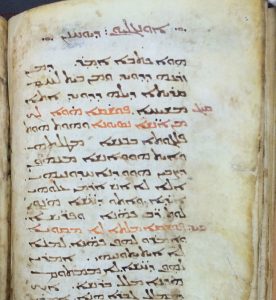Some time during the late sixth or early seventh century, somewhere in Roman Syria, a scribe named Gewargis sat down to copy a book. It was the Bible, or more precisely, a part of the Bible: the Gospel of John. The language was Syriac, a dialect of Aramaic and a major literary language throughout much of the Middle East. Gewargis had over 80 leaves of good parchment to use for his book, and since he was an accomplished scribe with a steady, clear hand, he could produce a high quality volume.

British Library, Add. 17119 (f.30v); portions of John 7, along with oracular statements inserted in red ink [Copyright © The British Library Board, All Rights Reserved]
Most striking of all, however, were the brief statements interspersed throughout the Gospel, statements that were certainly not part of its original text. They showed up at fairly regular intervals: “That which you were expecting will happen” (at John 3:9); “Do not do this thing” (at John 11:4); “What is lost will be found” (at John 6:13). They address the reader rather than characters in the narrative. Most of the statements seem positive, but occasionally one strikes a foreboding note, as in the middle of John 18, where it says, “The matter is evil.”
Gewargis would copy 308 of these statements into the gospel text. Although he wrote them in exactly the same hand, he made them stand out by putting them in red ink and numbering them in the margins of his book. Each one began with the Syriac term, pushshaqa, “interpretation.” But they were not interpretations in the sense most people today would understand. In the ancient world, people made copies of John’s Gospel that included hermeneia, a Greek term that means “interpretation,” but these tools had a very specialized use. Gewargis’ copy of the Gospel was not intended for corporate worship, devotional reading, or as the source of theological reflection in the preacher’s study. It was intended to be used in sortilege, the practice of drawing lots for the sake of telling an inquirer’s fortune. The special statements added to the text were couched as answers to the questions of someone who was seeking divine aid or knowledge.
Not much is known about this historic practice, except that it was common. Before Christianity, people commonly practiced divination by consulting passages of revered texts, such as Homer. Complex stand-alone systems of divination were also developed and became popular (e.g. Sortes Astrampsychi). Some Christians also used their scriptures as a source for divination, consulting passages at random in order to discern an immediate message from God. But at some point, Christians combined these approaches by formulating sets of oracular statements and attaching them to sacred texts, especially the Gospel of John and the Psalms, thereby synthesizing systems of divination that became fairly popular.
We know it was popular because we have records of official restrictions against the practice. But we also have vestigial evidence of the system dating from early times, in Greek and Coptic papyrus fragments of John that have oracular statements, known as hermeneia. Though very fragmentary, many of them agree in content, sequence, and number with the ones Gewargis has in his Syriac copy. We also have Latin, Armenian, and Georgian versions, though most of the surviving evidence is very fragmentary. In one early Armenian manuscript preserved in Austria, the material was erased and the book recycled, so that its oracles are barely legible.
The care and attention Gewargis put into making his book has been rewarded by the fact that his book is older and more legible than several of the other witnesses and its system of lot-oracles (sortes) is more complete than any others yet to be identified. The book resides now in London, under the designation: British Library, Additional Manuscript 17119. Jeff Childers and some of his students have been studying the material. Childers has presented on it in several conferences and is now editing the material for publication. The work promises to broaden our understanding of ways Christians used their books and applied the biblical text to daily life.


Dear Professor Childers,
Thank you for spreading the word about this volume. I am very interested in this topic, so I am looking forward to reading your contribution. However, the volume does not seem to be out yet, although in your curriculum that is to be found on the university’s page you mention the year 2015. Would you be kind enough to provide more details about it?
Many thanks!
Florin, thank you for your interest in this. The volume is certainly not ready, but the articles you mention from the CV on the university site will be appearing very soon. The publishers say they will be out next year. Not as early as we had hoped So please stay tuned!
Thank you for this interesting piece of information. I am curious about the Armenian manuscript in Vienna with similar divinatory additions. Is it possible to get the call number and location? I presume it is held at the Mechitarist Library? Thank you.
Thank you for your interest, Zara. Two people have done the most work on the Armenian evidence. I would point you to their published work to get the information you need. I hope it will be helpful:
Bernard Outtier. “Les Prosermeneiai du Codex Bezae,” in D. C. Parker/C.-B. Amphoux (eds.), Codex Bezae. Studies from the Lunel Colloquium, June 1994, Leiden 1996, 74–78.
Bernard Outtier “Réponses oraculaires dans des manuscrits bibliques caucasiens,” in C. Burchard (ed.), Armenia and the Bible (University of Pennsylvania Armenian Texts and Studies 12), Atlanta (Georgia) 1993, 181–84.
Erich Rennart. Ein spätantikes Los-Buch. Die Handschrift 2058/2 der Universitätsbibliothek Graz—Ein armenisches Palimpsest, Graz 2015.